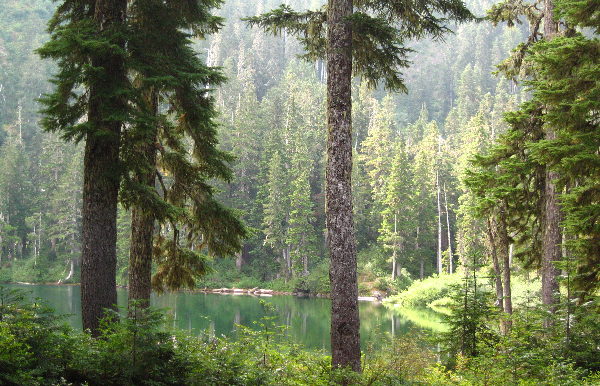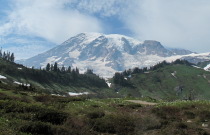- Yale Framework |
- Use Cases |
- Pacific Northwest
Pacific Northwest

Explore related items…
Climate change impacts on vegetation
A new assessment of the potential impact of climate change on vegetation in the Pacific Northwest of the USA shows a mosaic of vulnerable and resilient areas. Researchers found that coastal forests are vulnerable to large increases in fires, subsequent losses in carbon stocks, and encroachment from more southerly and/or easterly forest types. The dry, fire-adapted forests east of the Cascades are projected to be more resilient to climate change. With projected increases in precipitation, vast expanses of shrublands in the Columbia Plateau and Northern Basin could convert to grasslands or woodlands.
Due to a limited number of field experiments ( FACE or free-air CO2 enrichment ), we don't know how every plant species might respond to changes. As a result, models cannot be calibrated precisely for current vegetation cover. To try to alleviate some of the problems associated with the diversity of species-specific responses, climate scientists use dynamic global vegetation models where plant functional types (such as maritime evergreen forests) rather than species are used to simulate vegetation assemblages and the associated ecosystem processes.
The dynamic global vegetation model MC1 was used to simulate vegetation dynamics, associated carbon and nitrogen cycles, water budget and wild fire impacts across the western 2/3 of the states of Oregon and Washington. The model used historical climate data from the PRISM group (Chris Daly, OSU) at a 30arc second (~800m) spatial grain and anomalies from 9 future climate projections. The vegetation model only simulates potential natural vegetation and does not simulate the impacts of urbanization, agriculture, or industrial development.

The three GCMs used were the CSIRO Mk3 (from Australia), MIROC 3.2 medres (from Japan, and Hadley CM 3 (from UK) ( Table 8.1 in IPCC report Vol 1. ), each run using three different CO2-equivalent emission scenarios ):
* B1 (declining population by 2050, social stability and reliance on clean and resource efficient technologies)
* A1B (declining population by 2050, social interactions globally, and reliance on both traditional and renewable sources of energy)
* A2 (increasing population, self reliant nations, and fragmented technological changes).
 Temperatures are projected to increase throughout the region following the projected increase in CO2-eq emissions, but precipitation projections are more varied. For example:
Temperatures are projected to increase throughout the region following the projected increase in CO2-eq emissions, but precipitation projections are more varied. For example:
* CSIRO projections are relatively cool and wet
* MIROC projections are hot and wet
* Hadley projections are hot and dry.
Precipitation trends show a general increase in winter and a decrease in summer while highest temperature increases are projected for summer. Previous published work showed that CSIRO performed poorly, MIROC moderately well, and Hadley very well in the Pacific Northwest for the historical period.
Major outcomes of this modeling exercise include:
* The Pacific Northwest's coastal forests are vulnerable to large increases in fires, corresponding losses in carbon stocks, and encroachment from either more southerly and/or easterly forest types.
* The dry fire-adapted forests located east of the Cascades are projected to be fairly resilient to climate change.
* With increasing precipitation, the model simulates vast expanses of shrublands in the Columbia Plateau and Northern Basin converting to either grasslands or woodlands.
* Results for the CSIRO climate projections include an 82% increase in biomass burned and 1.2% (0.1 Pg C) decrease in carbon stocks for the region. For MIROC climate projections, projections show a 22% increase in biomass burned and 0.8% (0.07 Pg C) increase in carbon stocks.
* Climate projections from the Hadley model cause the most extreme changes, with almost a 3 fold increase in biomass burned and 15% (1.26 Pg C) decrease in carbon stocks.
 Model results are of course simplification of the real world and entirely dependent on model assumptions and uncertainties which come from 1) climatic inputs and particularly precipitation projections, 2) unknown plant species responses to elevated CO2, 3) future levels of emissions and subsequent nitrogen deposition, 4) ill-understood responses of belowground components of ecosystems.
Model results are of course simplification of the real world and entirely dependent on model assumptions and uncertainties which come from 1) climatic inputs and particularly precipitation projections, 2) unknown plant species responses to elevated CO2, 3) future levels of emissions and subsequent nitrogen deposition, 4) ill-understood responses of belowground components of ecosystems.
The CO2 fertilization effect in the model increased productivity and water use efficiency as atmospheric CO2 concentration increased. Recent publications (Mote et. al 2008) have shown that despite early results in the field ( FACE or free-air CO2 enrichment ) showing an enhancement of productivity and water use efficiency, some plants have acclimated and showed a lesser response to CO2 than at the beginning of the experiment. Moreover, the larger impacts occurred belowground (increased root turnover, increased belowground productivity). There is also evidence that nutrient availability constrains the long term response to increased atmospheric CO2. Consequently it is likely that this version of MC1 may have overestimated the positive effects of CO2 on plant growth in the future.
This work was the core of Brendan Rogers Master's thesis under Dr. Ron Neilson, his advisor and MAPSS team leader, USDA Forest Service PNW station, in the Dept of Forest Ecosystem and Society, at Oregon State University where he defended in the Fall of 2009.
References
Bachelet, D., R. P. Neilson, J. M. Lenihan, and R. J. Drapek. 2001. Climate change effects on vegetation distribution and carbon budget in the United States. Ecosystems 4, no. 3 (April 21): 164-185. doi:10.1007/s10021-001-0002-7.
Daly, C., M. Halbleib, J. I. Smith, W. P. Gibson, M. K. Doggett, G. H. Taylor, J. Curtis, P. P. Pasteris, and N. USDA. 2008. Physiographically sensitive mapping of climatological temperature and precipitation across the conterminous United States.
Gordon HB et al. (2002). The CSIRO Mk3 Climate System Model Aspendale: CSIRO Atmospheric Research. CSIRO Atm. Res. tech. paper no. 60.
Hasumi, H., and S. Emori, eds. 2004. K-1 Coupled GCM (MIROC) description. K-1 Model Developers Tech. rep. 1, 34 pp.
IPCC (2007). Climate Change 2007: The Physical Science Basis. Contribution of Working Group I to the Fourth Assessment. Report of the Intergovernmental Panel on Climate Change, Solomon, S., D. Qin, M. Manning, Z. Chen, M. Marquis, K 280 .B. Averyt, M. Tignor and H.L. Miller (eds.). Cambridge University Press, Cambridge, UK and New York, NY, USA.
Johns, T. C., J. M. Gregory, W. J. Ingram, C. E. Johnson, A. Jones, J. A. Lowe, J. F. B. Mitchell, D. L. Roberts, D. M. H. Sexton, and D. S. Stevenson. 2003. Anthropogenic climate change for 1860 to 2100 simulated with the HadCM3 model under updated emissions scenarios. Climate Dynamics 20, no. 6: 583-612.
Kuchler, A. 1975. Potential Natural Vegetation of the United States. 2nd edition. New York, NY: American Geographic Society.Nakicenovic, N., J. Alcamo, G. Davis, B. de Vries, J. Fenhann, S. Gaffin, K. Gregory, A. Grubler, T. Y. Jung, and T. Kram. 2000. Special report on emissions scenarios: a special report of Working Group III of the Intergovernmental Panel on Climate Change. PNNL-SA-39650, Cambridge University Press, New York, NY (US).
Mote, P., E. Salathe, V. Duliere, and E. Jump. 2008. Scenarios of Future Climate for the Pacific Northwest. Seattle, WA: Climate Impacts Group, University of Washington.
Norby, R. J., J. M. Warren, C. M. Iversen, B. E. Medlyn, R. E. McMurtrie, and F. M. Hoffman. 2008. Nitrogen limitation is reducing the enhancement of NPP by elevated CO2 in a deciduous forest. EOS Trans. AGU 89, no. 53. Fall Meet. Suppl., Abstract B32B-05.
Rogers, B. 2009. Potential impacts of climate change on vegetation distributions, carbon stocks, and fire regimes in the U.S. Pacific Northwest. MS Thesis, Oregon State University.
Salathe Jr, E. P., P. W. Mote, and M. W. Wiley. 2007. Review of scenario selection and downscaling methods for the assessment of climate change impacts on hydrology in the United States Pacific Northwest. International Journal of Climatology 27, no. 12.
Photo credits: Dr. Dominique Bachelet
- Citation
- Dominique Bachelet. 2010. Pacific Northwest. In: Data Basin. [First published in Data Basin on Jun 3, 2010; Last Modified on Oct 8, 2021; Retrieved on Jan 5, 2026] <https://databasin.org/articles/96a86e9d623244daaead93de31477bfa/>
About the Author
Dominique received her Master’s degree in 1978 in Lille (France) and her Ph.D. in 1983 from Colorado State University with a thesis focused on biogeochemical cycles in the shortgrass prairie. In 1984 she went to U.C. Riverside as a postdoc simulating nitrogen fixing shrubs in the Sonoran desert then...

